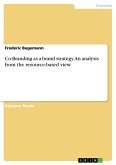Firms are continuously looking for new opportunities to exploit and leverage their existing brands for achieving business growth. In the past, companies have leveraged their most important asset (brands) through brand and line extensions. Nowadays, the most recent trend for capitalizing on brands is called Co- Branding in which two or more brands are presented jointly to the consumer, forming a new product or service offering. This new branding strategy promises many benefits, especially for international operating companies with strong global brands. As the result of the high rate of product failures, the intense competition among companies and the high costs to enter new markets, the use of co-branded products has become increasingly important for brand managers because they provide a way to take advantage of existing brand name recognition and associations. Co-branding came up in the early 90 s and has recently reached an all-time high with annual growth rates estimated at 40 percentages.
This study investigates fit in more detail and tries to find out which factors lead to a perceived fit between two brands by consumers. Given this research purpose the research question of this study can be formulated as follows: Which factors lead to a perceived fit between two partner brands by consumers?
The following sub-questions arise within the attempt to answer the research question: Are there any clear factors that lead to a fit between partner brands? , Are some factors more important than others? , If yes, which?
This study investigates fit in more detail and tries to find out which factors lead to a perceived fit between two brands by consumers. Given this research purpose the research question of this study can be formulated as follows: Which factors lead to a perceived fit between two partner brands by consumers?
The following sub-questions arise within the attempt to answer the research question: Are there any clear factors that lead to a fit between partner brands? , Are some factors more important than others? , If yes, which?








